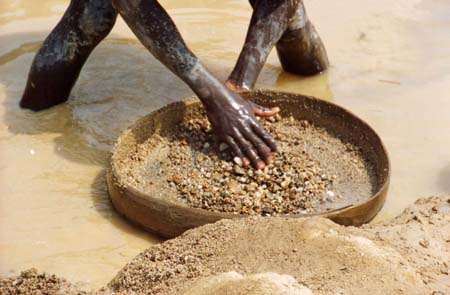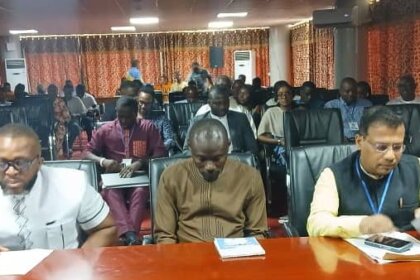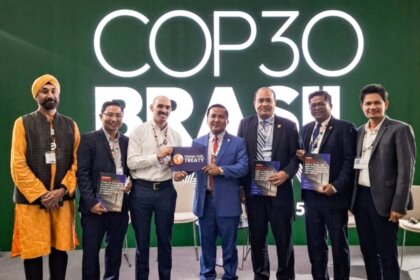The first Sierra Leonean diamond was found in 1930, and significant production commenced in 1935. By 1937 Sierra Leone was mining one million carats annually, reaching a peak of 2 million carats in 1960. From 1930 to 1998, approximately 55 million carats were mined (officially) in Sierra Leone. At an average price in 1996 dollars of US $270 per carat, the total value is close to $ 15 billion.
In 1935, the colonial authorities concluded an agreement with De Beers’ Sierra Leone Selection Trust (SLST), giving the company exclusive mining and prospecting rights over the entire country for 99 years. By 1956, however, there were an estimated 75,000 illicit miners in Kono District – the heart of the diamond area – leading to smuggling on a vast scale, and causing a general breakdown of law and order. The buyers and smugglers at that time were mainly Mandingo and Lebanese traders. With the tightening of security between Kono and Freetown in the early 1950s, Lebanese smugglers began moving their goods to Liberia. Antwerp, and then Israeli-based diamond merchants soon noticed the booming diamond trade-in Monrovia, and many established offices there. De Beers itself set up a buying office in Monrovia in 1954 to keep as much of the trade under its control as possible.

In 1955, the colonial authorities scrapped SLST’s nation-wide monopoly, confining its operations to Yengema and Tongo Field, an area of about 450 square miles. In 1956, they introduced the Alluvial Mining Scheme, under which both mining and buying licenses were granted to indigenous miners. Many of these licenses came to be held by Lebanese traders who had begun to settle in Sierra Leone at the turn of the century.
Siaka Stevens came to power seven years after independence in 1968. A populist, he quickly turned diamonds and the presence of SLST into a political issue, tacitly encouraging illicit mining, and becoming involved himself in criminal or near-criminal activities. In 1971, Stevens created the National Diamond Mining Company (NDMC) which effectively nationalized SLST. All important decisions were now made by the prime minister and his right-hand man, a Lebanese businessman named Jamil Mohammed. From a high of over two million carats in 1970, legitimate diamond exports dropped to 595,000 carats in 1980 and then to only 48,000 in 1988. In 1984, SLST sold its remaining shares to the Precious Metals Mining Company (PMMC), a company controlled by Jamil. Stevens retired in 1985, handing over power to Joseph Momoh, who placed even greater responsibility in the hands of Jamil.
From the late 1970s to the early 1990s, aspects of Lebanon’s civil war were played out in miniature in Sierra Leone. Various Lebanese militia sought financial assistance from their compatriots in Sierra Leone, and the country’s diamonds became an important informal tax base for one faction or the other. This was of great interest to Israel, in part because the leader of the important Amal faction, Nabih Berri, had been born in Sierra Leone and was a boyhood friend of Jamil. Following a failed (and probably phony) 1987 coup attempt in Sierra Leone, Jamil went into exile, opening the way for a number of Israeli “investors” with close connections to Russian and American crime families, and with ties to the Antwerp diamond trade.
The Revolutionary United Front (RUF) war began in 1991 and soon after, Momoh was replaced by a military government – the National Provisional Ruling Council (NPRC). Despite the change in government, however, RUF attacks continued. From the outset of the war, Liberia acted as banker, trainer, and mentor to the RUF, although the Liberian connection was hardly new. With a negligible diamond potential of its own, Liberia’s dealings in stolen Sierra Leone diamonds have been a major concern to successive Sierra Leone governments since the great diamond rush of the 1950s.

What was different and more sinister after 1991 was the active involvement of official Liberian interests in Sierra Leone=92s brutal war – for the purpose of pillage rather than politics. By the end of the 1990s, Liberia had become a major center for massive diamond-related criminal activity, with connections to guns, drugs, and money laundering throughout Africa and considerably further afield. In return for weapons, it provided the RUF with an outlet for diamonds and has done the same for other diamond producing countries, fuelling war and providing a safe haven for the organized crime of all sorts.
Joseph Momoh’s search for new investors in the early 1990s was carried forward by the NPRC military government. With De Beers out of the picture, and with the disappointing and short-lived Israeli experience behind it, the government now began to receive overtures from small mining firms, known in the business as “juniors”. The report deals primarily with the three juniors most involved in Sierra Leone during the 1990s, some with interests that extended far beyond the mining of diamonds.
All three trade on Canadian stock exchanges, no doubt because of Canada’s well-deserved reputation as a source of easy venture capital for small mining and exploration companies. The first, Rex Diamond – with de facto headquarters in Antwerp – has integrated mining, sorting, cutting, and marketing operation, holding Sierra Leonean concessions in Zimmi and Tongo Field. Although Rex claims friends among both government and the RUF, this is denied by the RUF, perhaps understandably. In 1998, Sierra Leone lost its only combat helicopter – a serious problem because the Soviet-built gunship had been the government’s most effective weapon against the RUF. Zeev Morgenstern, Rex’s Managing Director, and Serge Muller, the company’s President, came to the government’s aid by making an arrangement to supply engines, parts, and ammunition worth $ 3.8 million. The deal went sour as a result of defective parts supplied from Russia. According to the Washington Post, Morgenstern and Muller have both said, “..the arms deals were unrelated to Rexs mining activities”.
The second firm is Toronto-based AmCan Minerals, which holds various exploration licenses in Sierra Leone. Because of the security situation, AmCan has so far done little diamond mining, although it recently acquired a South African-owned firm, ArmSec International (SL) with connections to both the diamond and the security industries. AmCan’s Sierra Leone lawyer is Chairman of the Government Gold and Diamond Office, the body responsible for overseeing the monitoring, valuation, and taxation of the diamond industry.
The third “Canadian” firm is DiamondWorks, an outgrowth of Carson Gold and Vengold, companies promoted by Robert and Eric Friedland. In 1995, DiamondWorks acquired Branch Energy Ltd., a private company registered on the Isle of Man. DiamondWorks and Branch Energy have become the subject of widespread interest because of their apparent but much-denied connections with two major international security firms, Executive Outcomes, and Sandline. In 1995, The Government of Sierra Leone, backed onto the Freetown peninsula by the RUF and facing certain defeat, engaged the services of Executive Outcomes (EO) to help in its defense. With 200 imported soldiers, air support, and sophisticated communications equipment, EO pushed the RUF back from Freetown within a week, and within another month had cleared the major diamond areas of Kono as well. Shortly after EO took control of the diamond areas, Branch Energy – which had introduced EO to the GOSL – secured a 25-year lease on Sierra Leonean diamond concessions.
In 1997, DiamondWorks’ Sierra Leone country manager was seconded – as a “private citizen” – to Sandline, in connection with a controversial arms shipment intended for the briefly exiled government of Tejan Kabbah.
The juniors arrived in Sierra Leone when the formal instruments of the state had all but disappeared, notably law, order, probity, and justice. They also arrived in the midst of a war which had at its epicenter the same thing that brought them to the country – diamonds. Lawlessness, however, was not new. The government of Sierra Leone had – from the 1950s – given up pretending that it could police the diamond areas. From the days of the SLST Diamond Protection Force, it had encouraged and even required foreign investors to make their own security arrangements. This goes a long way to explaining why the juniors appear to have such an intimate relationship with private security firms.
There is a distinction to be made, however, between the need to hire a private security firm in order to police a mining operation, and the provision of troops and weapons in support of a faction in a civil war. It can be said that the involvement of Executive Outcomes in Sierra Leone was in a good cause. The company successfully protected the government against a brutal and illegitimate rebel force. EO was certainly cheered in the streets of Freetown for its efforts. It can also be said that the provision of weapons to the democratically elected government of Tejan Kabbah – a UN arms embargo notwithstanding – made sense and was in support of a good cause.
The problem is not the individual episodes, but the bigger picture which they help to form – of a world in which beleaguered and legitimate governments find little formal international protection against internal predators, and are forced into Faustian bargains in order to survive. Even though Sierra Leone is amongst the top ten diamond producing countries in the world, the third-largest deposits of rutile in the world and the largest in Africa, the majority of its citizens live in abject poverty – poor roads, lack of power supply, poor quality education, poor health care system, lack of housing, and many basic things a citizen have the right to access. It is of no surprise that corruption is the main cause of Sierra Leone’s underdevelopment. Many could recall that Sierra Leone used to have one of the best universities in Africa and also one of the best health care systems in Africa. Today, we have one of the worst health care systems in Africa, one of the worst infrastructural systems in Africa, one of the worst educational systems in Africa, etc. The question is, is Sierra Leone a resource curse country? Why a country like Sierra Leone with so many resources is still ranked among the poorest in the world?

















